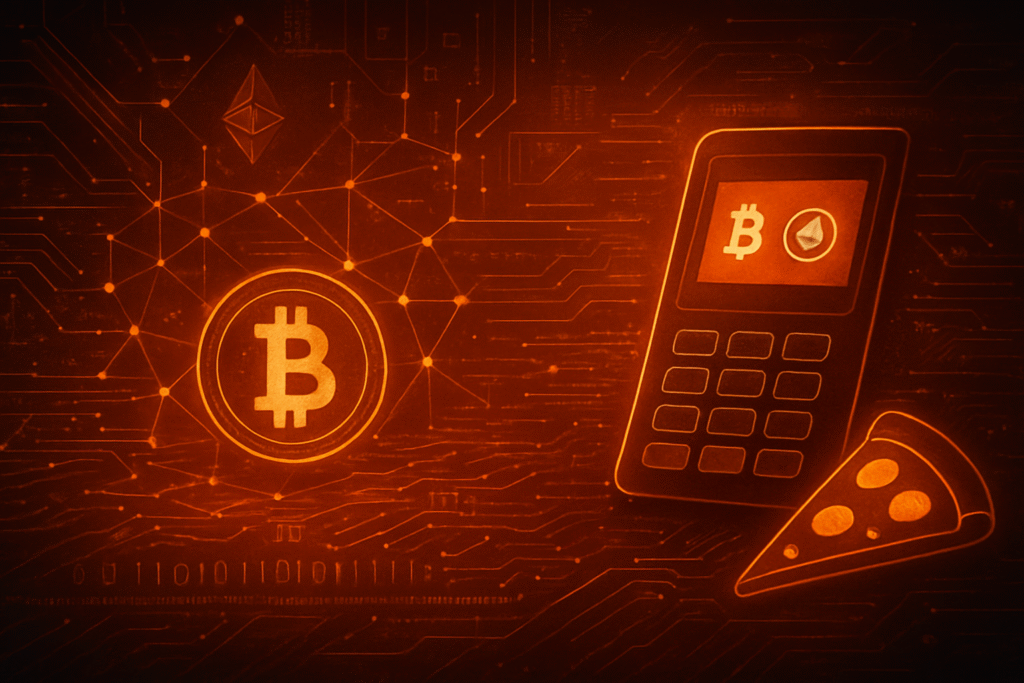
Nicosia, Cyprus – November 11, 2025 – In a landmark move poised to accelerate the integration of digital currencies into everyday commerce, Domino's Pizza (NYSE: DPZ), the global pizza giant, has officially partnered with xMoney to enable cryptocurrency and fiat payments, commencing with its operations in Cyprus. This groundbreaking collaboration, effective today, positions Domino's as a pioneer in the quick-service restaurant (QSR) sector, embracing the future of finance and "Web3 readiness."
The announcement has sent ripples through the crypto community, with enthusiasts hailing it as a significant validation of digital assets' growing utility. While immediate market reactions for associated tokens have been mixed, the long-term implications for mainstream crypto adoption are widely considered overwhelmingly positive. This partnership signifies a crucial step in bridging the gap between traditional retail and the burgeoning decentralized economy, offering consumers a faster, more seamless checkout experience without the typical complexities associated with crypto transactions.
Market Impact and Price Action
The immediate market response to the Domino's xMoney partnership has presented a nuanced picture. While the news itself is a significant bullish signal for crypto adoption, the price action of xMoney's native token, XMN (formerly UTK), has shown a mixed to slightly negative reaction. On November 11, 2025, XMN experienced declines ranging from 2.57% to 4.13% over the last 24 hours, with prices fluctuating between approximately $0.01812 and $0.0492 USD across various reporting platforms. Despite this immediate downward pressure, the community sentiment surrounding XMN remains largely bullish, suggesting that investors are viewing this partnership as a long-term catalyst rather than a short-term pump.
As a stablecoin, USDC, which is prioritized for its efficient processing on the Sui blockchain within the xMoney integration, maintained its peg, trading consistently around $0.999-$1.00 USD. This stability reinforces its role as a preferred medium for real-world transactions where price volatility is a concern. The Sui (SUI) blockchain, while benefiting from increased visibility due to its role in facilitating these fast payments, has seen its price action more influenced by broader market trends and its robust ecosystem developments, such as a record-high Total Value Locked (TVL) and significant decentralized exchange (DEX) volume in October. SUI has experienced recent declines from its January peak but also carries strong long-term bullish predictions from analysts.
The broader cryptocurrency market sentiment on November 11, 2025, remains cautious. Despite Bitcoin reaching $106K and some altcoins showing gains, overall open interest is low, and frequent liquidations suggest a risk-averse environment following a reported "October 11 crash." However, the Domino's partnership stands out as a beacon of real-world utility in this cautious landscape, potentially fostering a shift towards valuing projects with tangible adoption over pure speculation.
Community and Ecosystem Response
The crypto community's reaction to Domino's Pizza's foray into crypto payments via xMoney is a blend of enthusiastic optimism and discerning scrutiny. On social media platforms and forums, a wave of excitement is palpable, with many hailing the partnership as a pivotal moment for mainstream crypto adoption. Proponents emphasize the practical application of digital assets in an everyday scenario, highlighting the improved customer experience through faster and more seamless checkout processes touted by xMoney. The notion of a global brand like Domino's embracing "Web3 readiness" resonates strongly with those eager to see traditional businesses integrate decentralized technologies.
However, a segment of the community, including some crypto influencers and thought leaders, approaches the announcement with a degree of caution and critical analysis. Questions are being raised regarding the depth of crypto integration – whether it truly leverages decentralized principles or primarily functions as a centralized crypto payment rail. Discussions are also focusing on the specific cryptocurrencies that will be supported beyond USDC, the associated transaction fees, and the potential for the initial Cyprus rollout to be a slow burner for wider global expansion. Despite these queries, the consensus among thought leaders is that such a high-profile partnership unequivocally legitimizes crypto as a viable payment method. Influencers are likely to continue analyzing xMoney's technical implementation, particularly its reliance on the Sui blockchain for efficient USDC processing, and its broader implications for market dynamics.
The ripple effects on related DeFi protocols and Web3 applications are anticipated to be significant. The partnership underscores the critical need for efficient and user-friendly crypto payment gateways, potentially spurring increased development and investment in DeFi protocols focused on real-world transactions and cross-chain interoperability. The explicit mention of USDC on the Sui blockchain could boost attention and adoption for the Sui ecosystem. Furthermore, Domino's' move towards "Web3 readiness" is expected to inspire other retail and food service giants to explore similar integrations, driving innovation in Web3 applications for customer loyalty programs, supply chain management, and decentralized identity solutions. The emphasis on a "seamless payment experience" also serves as a strong signal for DeFi and Web3 developers to prioritize intuitive design to onboard mainstream users effectively.
What's Next for Crypto
The Domino's Pizza and xMoney partnership represents more than just a new payment option; it's a significant harbinger for the future trajectory of the crypto market. In the short term, this collaboration will undoubtedly boost crypto's visibility and legitimacy in the eyes of the general public. As consumers use digital assets to purchase their favorite pizzas, the abstract concept of cryptocurrency transforms into a tangible, convenient reality. This will place competitive pressure on other major retailers to explore or accelerate their own crypto payment integration strategies, fostering a ripple effect across the retail sector. The focus on stablecoins like USDC for transactions will likely see an uptick in their usage, mitigating volatility risks for both consumers and merchants.
Looking further ahead, the long-term implications are profound. This partnership serves as a powerful case study, accelerating mainstream adoption by demonstrating the practical utility of digital currencies beyond speculative trading. Businesses stand to benefit from potentially lower transaction costs compared to traditional credit card processors, fostering a broader shift towards crypto payments. The ability to facilitate faster, cheaper, and more secure cross-border transactions could also empower retailers to expand their global reach more efficiently. Crucially, this collaboration helps bridge the gap between traditional Web2 commerce and the decentralized Web3 economy, laying groundwork for a more integrated digital financial ecosystem, potentially leading to innovative crypto-based loyalty programs and tokenized rewards.
Several catalysts will be critical in shaping this future. Regulatory clarity, such as Europe's MiCA framework and potential U.S. legislation, remains paramount to de-risk institutional participation and build consumer confidence. Continued technological advancements in layer-2 solutions, cross-chain interoperability, and user experience (UX) improvements are essential to make crypto transactions as seamless as traditional payments. The ongoing growth of regulated crypto products, like Bitcoin and Ethereum spot ETFs, will continue to attract significant institutional capital, further legitimizing the market. Additionally, the tokenization of real-world assets (RWAs) and the continued embrace of digital coins by major payment networks like PayPal, Visa, and Mastercard will embed crypto deeper into existing financial infrastructure.
For crypto projects, the strategic imperative is clear: focus on real-world utility, develop robust compliance infrastructure, and prioritize seamless integration with user-friendly design. Investors, meanwhile, should consider diversification, prioritize compliant and utility-driven entities, and deeply understand tokenomics and fundamentals. Possible scenarios for broader crypto adoption range from "Ubiquitous Utility," where crypto is an indispensable part of a global financial system, to "Enhanced Retail Niche," where it thrives in specific segments, or even "Stablecoin Dominance," where stablecoins become the primary currency for retail transactions. The Domino's xMoney partnership undeniably pushes us closer to the "Ubiquitous Utility" scenario.
Bottom Line
The partnership between Domino's Pizza and xMoney for crypto payments in Cyprus is a watershed moment for the cryptocurrency ecosystem. For crypto investors and enthusiasts, the key takeaway is the undeniable validation of digital assets as a legitimate and practical medium of exchange by a globally recognized brand. While the immediate price action of XMN has been somewhat muted, the long-term significance lies in the precedent this sets for broader institutional adoption and the tangible demonstration of crypto's real-world utility.
This development underscores the growing maturity of the crypto payments landscape, driven by innovative solutions like xMoney that prioritize speed, security, and user experience. It highlights the increasing importance of stablecoins for everyday transactions and the role of efficient blockchains like Sui in facilitating them. As we move forward, monitoring the expansion of this partnership beyond Cyprus, the volume of crypto transactions processed, and the reactions of other major retail players will be crucial metrics. This is not merely a payment integration; it's a testament to the inexorable march of digital assets into the mainstream, promising a future where paying with crypto for your pizza is as common as using a credit card.
This article is for informational purposes only and does not constitute financial or investment advice. Cryptocurrency investments carry significant risk.






